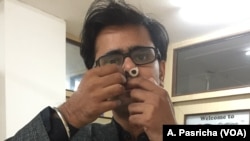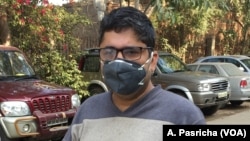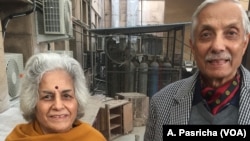People walking outdoors with masks are an increasingly common sight in the capital of India, where the toxic air, which ranks among the world's dirtiest, has rung alarm bells. Now a team of innovators from the prestigious Indian Institute of Technology, New Delhi, is offering another solution: a tiny respiratory filter that can be stuck in the nose to restrict particulate matter from entering the body without hampering breathing.
The project involved creating a thin, flexible membrane which blocks out most dust and air pollutants, including concentrations of the deadly PM 2.5, the tiny particulate matter which doctors say causes maximum damage to lungs.
The innovation, called Nasofilters, won the Indian president's "National Startups Award" last May and was featured in South Korea's 2017 list of "Top 50 technical startups in the world."
The idea of nasal filters is not new, and some are available in Western countries to help reduce exposure to allergens such as pollen. One study conducted in 2016 on a product made in Denmark found it reduced symptoms of allergies and was comfortable to use.
The Indian device, however, focuses on the country's pressing problem of air pollutants. Working out of one room on the sprawling IIT campus, which has been the home of several innovations, the young team is optimistic it will find acceptance in a city where the toxic cocktail of vehicle fumes, construction dust and burning waste spikes to as much as 30 times the safe limit in winter.
Shaped roughly like a fingernail, the dark brown membrane is made by assembling millions of small-sized pores and resembles a fine, porous cloth.
The costs have been held down to ensure the filter is within the reach of most people: It is priced at approximately 16 cents. Effective for around eight hours, the innovators claim it can filter out 95 percent of the pollutants.
Origins of the invention
Prateek Sharma started working on the idea along with some faculty members and others when he enrolled at IIT for engineering studies. The inspiration: His mother suffered from asthma.
"The initiation of this story was about a decade back. I always noticed my mother is wearing some kind of cloth on her face. That has always annoyed me," said Sharma, the 25-year-old who now heads the startup which produces the filters, Nanoclean Global Private Ltd.
Noticing she refused to wear a mask when she went outside, he set out to search for another solution.
"The problem is mega, the product is nano," said Sharma, pointing to the filters. "It's comfortable to wear, it is aesthetically not bothering them like a face mask which covers half of your face. There is a problem — I can't even eat, can't even talk to you while putting on a face mask."
Growing curiosity
Reports of the product in Indian media have piqued curiosity in the city.
Ashok Joshi, a retired senior army officer who lives in Delhi, made the trip to IIT with his wife to find out more about the filters and pick them up after reading reports about it in newspapers.
"We are outdoor people by and large, being in the army, mostly I am outdoors," he said. "If something is there, which does not look very ugly and you can wear it comfortably, excellent idea. Why not?"
On days when air pollution is categorized as severe, doctors advise people, especially children and the elderly, against outdoor activities. On New Year's Day, New Delhi's air pollution levels bordered on severe.
The nose filter's real test lies in winning acceptance from people like Joshi as they try it out in the weeks and months ahead.
While the invention, if it proves acceptable to consumers, may help people protect themselves from the dirty air, environmental activists stress that the pressing need is to address the causes of the air pollution: the city's huge vehicle fleet and smoke from fires.
India's air pollution crisis is not restricted to New Delhi — nine other Indian cities figure among the WHO's list of the world's 20 most polluted cities.










